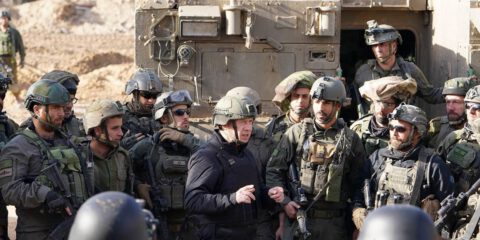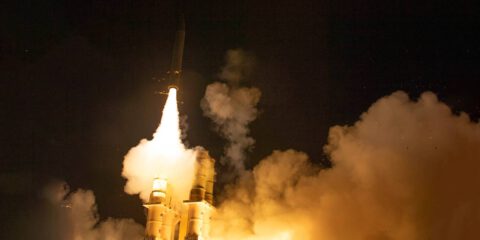The Shi’ite militia threat isn’t a mere thought exercise about a worst-case scenario. Iranian-controlled Popular Mobilization Forces leaders have already threatened Israel only miles from Israeli homes.
Israeli commanders and political leaders are talking about a conflict on the country’s northern border as a matter of when, not if. And it will be a conflict far more complex and dangerous than the war against Hezbollah in 2006. “This won’t be the Third Lebanon War,” said one IDF officer. “This will be the First Northern War.”[i]
The term “the First Northern War” envisions a fight in both Lebanon and Syria. Hezbollah is the main threat, and a dangerous adversary. Since 2006, Hezbollah has become far more capable, restocking its arsenal, gaining experience in Syria, and fighting alongside conventional militaries and other Iranian proxies in offensive operations far from their home territory. The Shiite organization coordinates with tactical air assets, creates long-range logistical networks, fights with proxy forces, conducts urban warfare, and more.
But the IDF won’t be facing only Hezbollah in the next war in the north. The evidence points to the participation of Iranian-controlled Shi’ite militias, organizations that will present considerable challenges to Israel.
The militias are a significant investment for Iran, and a central element of their policy in the Middle East. Ties with armed groups allow Iran to build a long-term presence across multiple countries. When Tehran decides to expand its involvement in or control over a country, it does not need to go through the difficult process of identifying potential allies and building rapport. This expanded involvement usually emerges when Iran feels the US and its allies are encroaching on strategic territory, and when Shi’ite communities are under threat from Sunnis. It is effective in countries torn apart by sectarian conflict, where local Shi’ites seek a means of protecting themselves and punishing their adversaries. This model proved itself with Hezbollah in Lebanon, and Iran is replicating it in Iraq, Syria, and in Yemen.
Shi’ite militias are not identical, nor are they new. In the brutal Iran-Iraq War in the 1980s, Iran organized sympathetic Shi’ite Iraqis into militias. More than 4,500 foreign Shi’ites died fighting for Iran in that war, including many Iraqis. Some of Iraq’s militias are entirely loyal to Tehran and to Khamenei, while others are of a nationalist bent and seek to limit Iranian control of the country. But the most capable and dangerous organizations are those controlled by Iran, and, not surprisingly, they pose the threat to Israel.
The militias have been especially useful for Tehran in Iraq, the Shi’ite-majority neighbor that was recently dominated by the US. With the ISIS invasion in 2014, and Iraqi Ayatollah Ali Sistani’s call to arms, the Shi’ite militias expanded rapidly, forming the Popular Mobilization Forces (PMF), ostensibly to fight ISIS. Today they number over 100,000 and have been incorporated into Iraq’s security forces. Though they were instrumental in the fighting, the PMF took part in atrocities against Sunnis, and battled the Kurds too.
With Iranian support, the PMF gained political power and control over several key ministries. In the May 2018 general elections in Iraq, the Fatah Alliance – composed of the leading Khameinist organizations – came in second place, and thenreached an agreement with the Sadrist Sairun Alliance to back Shi’ite Adel Abdul Mahdi as prime minister. Like the Islamic Revolutionary Guards Corps in Iran, the Khameinist militias exist outside the military chain of command and serve at the pleasure of the Supreme Leader. Their rise in Iraq – militarily and politically – is testament to the IRGC’s skill at creating armed proxies and using them to advance Iranian policy aims.
But it’s not their prominence within Iraq that represents the threat to Israel. It is their military experience and capabilities, developed over years of fighting under Iranian direction.
Formed during the Iran-Iraq War, the Badr Organization is the oldest of the Iranian-controlled militias. It is also the most powerful. It has become deeply involved in Iraqi politics, and its leader Hadi al-Amiri – a former minister in the Iraqi government – was a leading contender to become Iraq’s prime minister. Fully loyal to Khamenei, Badr may have as many as 50,000 fighters, but likely closer to 20,000.[ii] The militia, which is in close contact with the IRGC-Qods Force, featured prominently in the fight against ISIS in Tikrit, Fallujah, and the Mosul area.
Kata’ib Hezbollah, currently designated the PMF 45th Brigade, initially formed in 2004 to attack Coalition forces. The organization is considered a terrorist group by the US. Its leader, Abu Mahdi al-Muhandis, has long maintained ties with the IRGC, and was convicted for his role in attacks on US and French embassies in Kuwait in 1983. Though it has featured prominently in the fight against ISIS in Ramadi, Karmah, and Tel Afar, it is much smaller than Badr, with probably around 1,000 fighters. It has another 10,000 fighters in its Saraya al-Difaa al-Shaabi proxy, with up to 3,000 deployed to Syria.
Created as an anti-American force in Iraq, Asaib Ahl al Haq (AAH) split off from the Sadrist Mahdi Army, and is the PMF militia most closely affiliated with Lebanese Hezbollah. Its fighters have been trained by Hezbollah in Iran, fought alongside Hezbollah in Syria, and have mimicked Hezbollah’s model by establishing political, religious, and social services in southern Iraq. From 2006-2011, AAH claimed over 6,000 attacks on Coalition forces. It currently has around 10,000 fighters, with 1,000-3,000 fighting in Syria. AAH took a leading role in the anti-ISIS fight, especially in Diyala Province, Amerli, Tikrit, and Mosul. From its deep anti-American roots, AAH became in effect an American partner in fighting ISIS.
During the 2017 Battle for Mosul, the PMF was not allowed to take part in the fighting within the city itself, but encircled Mosul from the West by taking Tal Afar. They surprised their allies with the speed of their maneuver. They also took part in the capture of the Syrian border city Abu Kamal, completing the land bridge from Iran to the Golan Heights.[iii]
In Syria, Iraqi PMF forces have fought alongside Hezbollah and the IRGC. They have shown that they are deployable and can operate alongside the core of Iran’s expeditionary force.
Tehran began using the Hezbollah model in Syria in 2013. Its Syrian organizations, like the Abbas Brigade and the Abbas Forces, indoctrinate recruits in the ideology of velayat-e faqih, complete fealty to Khamenei. They see themselves as part of Iran’s regional Shi’ite network, willing to fight for Iran’s broader goals in the region beyond Syria.[iv] They regularly deployed near US-backed forces and on Israel’s border. In March 2017, an Iraqi Shi’ite militia announced for formation of the Golan Liberation Brigade, which deployed near Israel’s Golan border.[v] Though Syrian Shi’ite militias have only attracted between 8,000-12,000 fighters, up to 30,000 foreign Shi’ites have deployed in Syria. In a war against Israel, Hezbollah and Syrian forces will likely be bolstered by these battle-tested Shi’ite volunteers.
In the next conflict on Israel’s northern border, it is hard to imagine Iran forgoing the use of its Shi’ite militias. Though they are of uneven quality, the fighters have seen both irregular and conventional combat. They can deploy far from home, are fanatically loyal to Iran, have fought shoulder-to-shoulder with Hezbollah, and are willing to die to promote Iranian aims.
They represent a major asset for Hezbollah. Recruiting from Lebanon’s 1.65 million Shi’ites, Hezbollah manpower is limited. But with more than 66 million Shi’ites in Iran, and more than 30 million in Syria, Afghanistan, and Pakistan, Hezbollah knows it has a deep reservoir of reserves once it starts losing men to Israel’s superior firepower and capabilities. Tens of thousands are combat veterans, eager to fight the Zionist enemy on Tehran’s behalf. With the land corridor to Lebanon open, it will be harder for Israel to break Hezbollah’s fighting spirit, as the possibility of reinforcement and resupply – in other words, hope- will likely keep its fighters going.
Israel must pay closer attention to the PMF and other Shi’ite forces. Intelligence assets must be committed to studying these militias and their capabilities. Wargames focusing on regional scenarios should include players representing the militias. Israeli diplomats should be working overtime to convince US leaders to limit the growth of these groups, and the IDF should dedicate some of its air and special forces attacks to keeping Iranian proxies far from its borders.
The Shi’ite militia threat isn’t a mere thought exercise about a worst-case scenario. PMF leaders have already threatened Israel only miles from Israeli homes. In December 2017, AAH leader Qais Khazali visited Kafr Kila on the Israel-Lebanon border.
“I’m here with my brothers from Hezbollah, the Islamic resistance,” he declared. “We announce our full readiness to stand as one with the Lebanese people, with the Palestinian cause, in the face of the unjust Israeli occupation, which is anti-Islam, anti-Arab, and anti-humanity, in the decisive Arab Muslim cause.”
In August 2018, reports surfaced of Iran transferring ballistic missiles to Shi’ite militias in Iraq, while helping them develop the ability to create missiles on their own. These missiles – with ranges of 200-700 km- could potentially strike Israel and Saudi Arabia from within Iraq.[1]
The danger is clear. It is Israel’s responsibility to prepare accordingly.
JISS Policy Papers are published through the generosity of the Greg Rosshandler Family.
photo: Tasnim News Agency [CC BY 4.0]
[1] John Irish, Ahmed Rasheed, “Exclusive: Iran moves missiles to Iraq in warning to enemies,” Reuters, August 31, 2018.
[i] Nahum Barnea, “The First Northern War,” Yediot Ahronot, February 1, 2018. (Hebrew)
[ii] Figures on militias manpower and deployment come from Garret Nada and Mattisan Rowan, “Part 2: Pro-Iran Militias in Iraq,” The Wilson Center, April 27, 2018.
[iii] Spyer & Al-Tamimi, “How Iraq Became a Proxy,” The Tower.
[iv] Phillip Smyth, “Iran is Outpacing Assad for Control of Syria’s Shia Militias,” The Washington Institute, April 12, 2018.
[v] Ibid.









 - בניית אתרים
- בניית אתרים